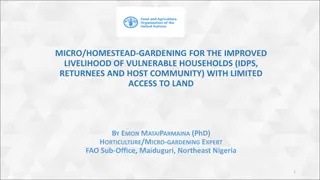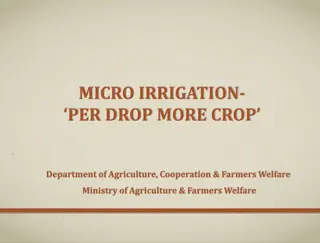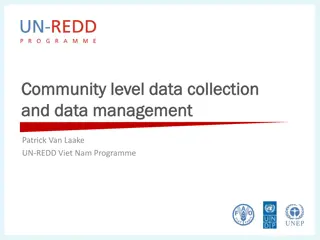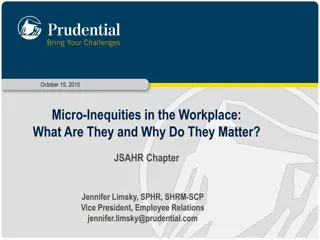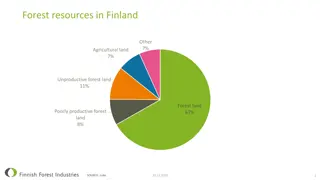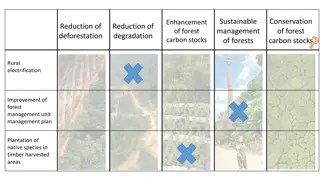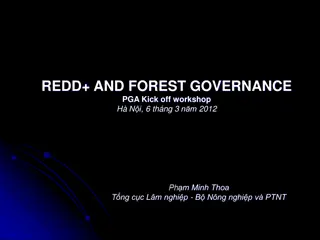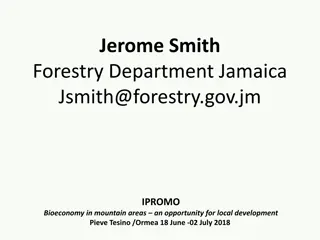Empowering Communities Through Micro Planning for Forest Development
Micro Planning is a community-based process empowering forest-dependent communities to create a roadmap for sustainable development. Joint Forest Management Committees and other bodies organize the preparation of ten-year development plans prioritizing activities for enhanced livelihoods. The process assesses resource utilization, identifies challenges, and aims to distribute benefits equitably. Components include entry point activities, action plans, and detailed financial aspects. Objectives focus on community participation, resource assessment, and scheme prioritization. The central theme highlights social, environmental safeguards, and focuses on the participatory management of forest resources by local communities.
Download Presentation

Please find below an Image/Link to download the presentation.
The content on the website is provided AS IS for your information and personal use only. It may not be sold, licensed, or shared on other websites without obtaining consent from the author. Download presentation by click this link. If you encounter any issues during the download, it is possible that the publisher has removed the file from their server.
E N D
Presentation Transcript
M MICRO ICRO P PLANNING LANNING
MEANING OF MICRO PLAN Micro Planning is a community based empowering process for preparing a road map for development and management of forest and livelihood enhancement of the forest dependent communities with properly defined roles and responsibilities of all stakeholders, clearly set targets and well discussed deadlines. Micro Plan prepared by community, organized into Joint Forest Management Committees (JFMC) / Village Forest Development Society (VFDS) and Eco Development Committees (EDC) in accordance with the Joint Forest Management Resolution, 2008. It is a Ten Year Development Plan encompassing the expectations of majority of the people, particularly the forest dependent communities, and other socially differentiated sections. This plan needs to have a prioritized list of activities for overall sustainable development of the village planned around the available natural and human resources.
COMPONENTS OF MICRO PLAN Micro plan describes the Entry Point Activities for supporting activities made on the basis of the findings from the PRA exercise. non-forestry Micro plan is basically the Action Plan for the forest related activities in the PFM area. Micro plan highlights the aspects of future plan with detailed techno-administrative and financial aspects.
OBJECTIVES OF MICRO PLAN 1. Ensure actual participation of the villagers for proper utilization of resources for the preparation of area/village/JFM/PFM/EDC specific forest development plan. 2. Assess the dependence of communities on the forest resources. 3. Assess the quantity, quality and present utilization of forest resources by the villagers. 4. Identify the importance of existing forest resources. 5. Identify the challenges encountered by the villagers in utilizing the services of the forest and find solutions therein. 6. Prioritize the schemes to be undertaken according to the social, cultural, political and economic situation of the villagers and the availability of natural resources. 7. Ensure that the benefits of the schemes planned and implemented reach all stakeholders.
CENTRALTHEME FORTHE PREPARATION OF MICRO PLAN It has to be prepared by JFMC/VFDS/EDC members themselves, with the support from Animators, the Forest Department and other specialists with focus on participatory spirit of communities in forest management and care of the needs of the local communities. 1. Social and Environmental Safeguards Prioritized activities and action plans for implementation Physical and financial details of different works. 2. Social Dimensions User groups/Common Interest Groups Tribal and other vulnerable sections Income and expenditure details
CENTRALTHEME FORTHE PREPARATION OF MICRO PLAN CONTD .. Others Village will be the unit for preparing a micro plan. Focus will be on the available resources of the village. Local people should be motivated for vibrant participation and co- preparation. One public meeting should be convened to discuss the objectives, process and expected outcome from the micro plan. The micro plan document should be simple and easy to understand. Local resources should be aligned with local requirements and objectives of the programme. The micro plan should be prepared within 20-25 working days. The micro plan should include and build on traditional community management and conservation practices. Participatory method should be used to assess requirements of the villagers. 3.
PRE-REQUISITES FOR MICRO PLANNING For initiating the exercise for preparation of Micro Plan, following works should have been completed Formation of JFMC/VFDS/EDC Large (1:10,000) scale map of the area Preliminary community on Micro Plan. sensitization of the
FORMATION OF JFMC/VFDS/EDC WORKING GROUP This group shall be constituted by the Executive Committee JFMC/VFDS/EDC. General Body meeting on Constitution of Working Group The working group generally consists of following members Four members (at least one woman) from JFMC/VFDS/EDC. Member Secretary. Animator. (EC) of the
Participatory Empowerment Sensitization Awareness External Facilitation Mobilization Organization R Collective Reflection E S L E Negotiation / Conflict Resolution I A N L Consensus F C Collective Action E
METHODAND DATAFOR MICRO PLAN Method of Data Collection Participatory Rural Appraisal (PRA) is the instrument to prepare the Micro Plan. DATA Collection on; Physical and financial resources in the area. Types of degraded land, their location and description. Population Existing livestock population. Social and Economic Survey data of the village Data on Natural Resources with focus on Forest Resources in the village.
RELATEDTOTHESPECIFICAREA Spatial location map with timeline. The roles and responsibilities of stakeholders. Record maintenance modalities. Social and Resource mapping. Share of draft plan with Stakeholders. Incorporation of and feedbacks /suggestions. Approval of Plan by DFO/ DCF. MoU between JFMC/VFDS/EDC and Forest Department for the implementation of plan.
ACTION STEPSFOR MICRO PLANNING The planning stage is important and can be divided into 3 steps Step I Village identification Step II Methodology Step III- Implementation VILLAGE IDENTIFICATION The village: - Brief introduction of the village. The Micro plan: - Description of the villagers and the frontline staff of micro plan. Details of the village: Description on natural / created resources , problems, need of the village and villagers. Justification for selection of village:- It will describe the reasons for selection of the village for program implementation. Methodology:- It will deal with the Procedures for preparation of micro plan, and Modes of People s participation.
ACTION STEPSFOR MICRO PLANNING Description of the village (i) Geographical / political location :- This section will include the details of location of village (ii) Communication facilities:- This section will deal with the infrastructure for communication and transportation facility. (iii) Natural and created Resources: - It will deal with the available natural resource and other manmade structures created in the past for the villagers. (iv) Climate:-This will include the distribution of rainfall temperature and humidity condition of the villages. (v) Population structure: - This will deal with the details of male, female, employment rate child mortality etc. (vi) Land use patterns: - It will deal with the different types of land uses and their status. (vii) Socio - Economic status: - This will deal about the social setup, economic condition, land holdings their earnings and Livestock status etc. The outcome of the above exercise will be accompanied by the preparation of (i) village map (ii) village social map (iii) village resource map.
ACTION STEPSFOR MICRO PLANNING To prepare a micro plan, various steps are needed to be executed in a systematic manner and through an accepted methodology. The whole process can be accomplished in following steps. (i) Secondary data: (ii) Primary data: - (a) Bio-physical data:-This includes biological and physical components of the village. (b) Socio economic data: - This includes socio-cultural, political and economic components. (iii) Data Analysis:. (iv) Recommendations: -. IMPLEMENTATION The recommendation given in the micro plan are to be implemented judiciously as per the availability of funds and importance of the activities, therefore, it is important to give details of the followings items in the micro plan. (i) Budget:. (ii) Monitoring and Evaluation: -. (iii) Rights and responsibilities:



